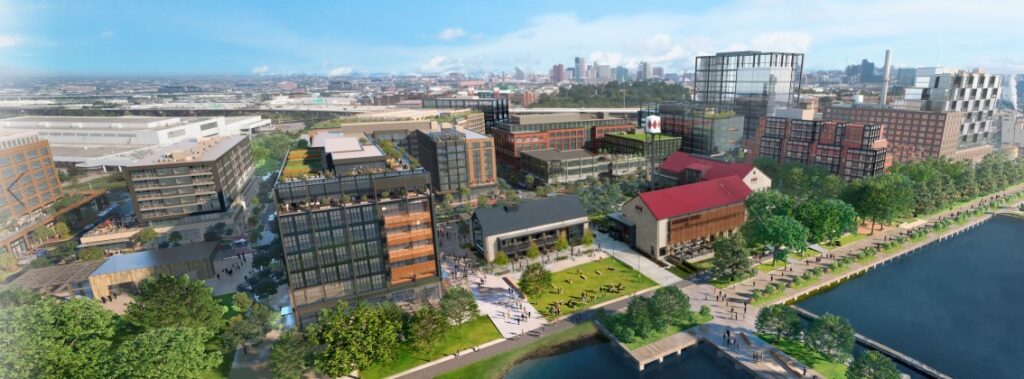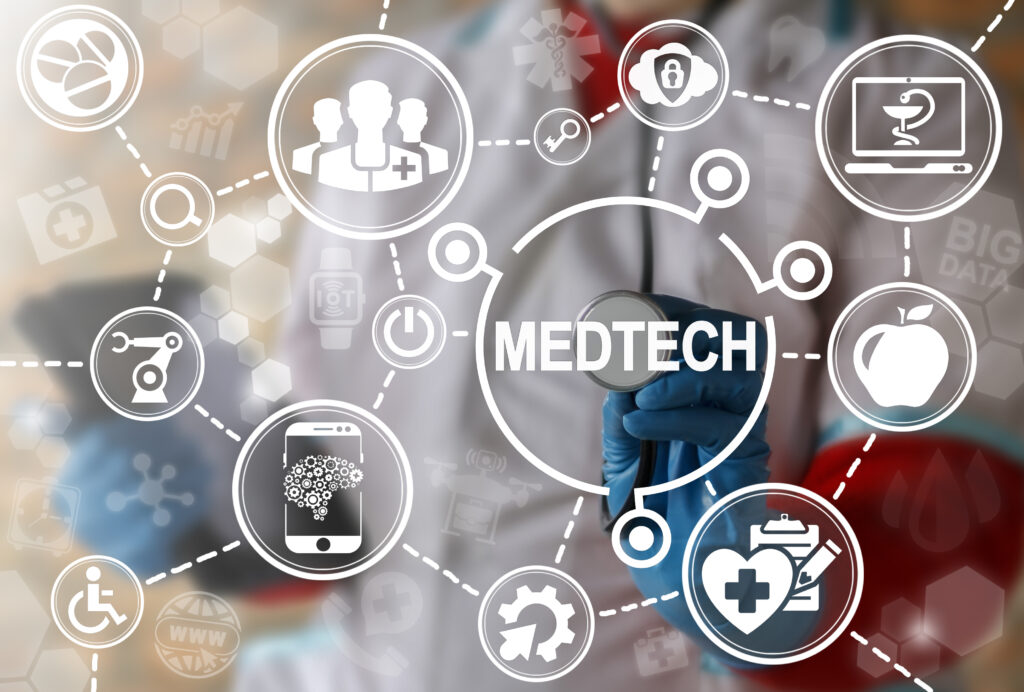
At a one-of-a-kind, 30,000-square-foot facility inside a former bus depot, a cluster of companies is advancing initiatives they hope will profoundly change human health and Baltimore’s future.
LaunchPort, a medtech venture center located inside Port Covington’s City Garage, was designed to provide robust business support and fill an infrastructure gap for emerging technology developers who are trying to bring new medical devices to market. The founders anchored LaunchPort with a medical device manufacturing plant.
“We wanted to create a facility that was actually making things,” said Managing Partner Bob Storey. “That has turned out to be an interesting and powerful part of the model. We essentially created a pilot plant for companies that are figuring out the different components of good manufacturing processes or GMP.”
Ten medtech startups, which currently operate out of LaunchPort, use that infrastructure to build engineering modules and prototype manufacturing systems, determine their needs for clean rooms and other specialized facilities, and refine their supply chain, warehouse management and quality control systems.

“So when the time comes for these companies to sit with a developer and plan their 20,000-square-foot or 50,000-square-foot facility hopefully close by in Port Covington, Cherry Hill or elsewhere in Baltimore, they will know exactly what they need,” Storey said.
That ecosystem, he said, has the potential to trigger the creation of numerous medical device factories and manufacturing jobs. LaunchPort’s tenant companies have pioneered devices to aid cardiovascular and cardiopulmonary procedures, vision-restoring corneal procedures, soft-tissue reconstruction, at-home dialysis and diagnostics for respiratory and sexually transmitted diseases. One tenant, Galen Robotics (whose robotic systems aid microsurgery), graduated from LaunchPort in late 2019, moved on to facilities in Pigtown and announced plans to hire more 100 people.
Scooter Monroe, Vice President and Head of Office Leasing at Weller Development, sees LaunchPort and City Garage, which also houses the Betamore accelerator for tech companies, as the foundation for an ecosystem at Port Covington that supports tech innovators and entrepreneurs.
“There is a tremendous amount of talent and resources in this region but the Baltimore tech and innovation ecosystem has been very disaggregated. There has never been a central hub of that activity,” Monroe said.
To determine how to create that central ecosystem at Port Covington, a team from Weller traveled the country and studied other technology hotbeds, including Boston, Nashville, Pittsburgh and Silicon Valley. They developed a strategy to support accelerators, like LaunchPort and Betamore, and began working on bringing one additional, vital and hard-to-get element into the ecosystem — venture capitalists.
“Some of the first tenants that we have talked to for Port Covington are in the venture capital space, specifically in cyber security and life sciences,” Monroe said. “Our goal is to stock the pond and create a space where if you are an entrepreneur with a tech innovation, you want to be in Port Covington because that is where things are happening.”
In addition to developing City Garage, Weller tailored Port Covington’s development plans to meet the real estate needs and desires of tech companies, including high-efficiency high-rise office buildings, boutique offices set among signature amenities, and a vibrant, waterfront live-work-play environment that appeals to young workers. Weller also partnered with Alexandria Real Estate Equities, a best-in-class investor and developer of life sciences spaces.
The goal of the Port Covington plan, Monroe said, “is to help Baltimore live up to its potential as a world-class city.”
Other current initiatives are also working to expand Baltimore’s tech sector.
At TEDCO, officials say Maryland’s vast research, innovation and tech resources need to become more integrated in order for the state to realize its full potential.
“There is more that needs to be done to knit everything together in a way that allows us to be as competitive as possible with Silicon Valley, Boston and Austin,” said Troy LeMaile-Stovall, CEO and Executive Director of TEDCO.
To facilitate that “knitting,” TEDCO is preparing to launch the Urban Business Innovation Initiative (UBII). Focused initially on Baltimore City and Prince George’s County, UBII is designed to support tech innovators, in part, by creating a “super Dropbox or super Wiki” that catalogues all the tech companies, ongoing research, infrastructure, financial resources, accelerator programs, industry developments, etc. to help entrepreneurs overcome challenges. LeMaile-Stovall hopes UBII will help entrepreneurs who don’t have broad networks, make more connections and access more resources.
“That is how we build an eco-system and a better Baltimore. We have to find a way to include more people and expand opportunities to those who don’t normally get those opportunities. It is about wealth expansion, wealth inclusion,” LeMaile-Stovall said.
Meanwhile, the newly formed UpSurge Baltimore is working to support high-potential, homegrown tech companies. The coalition of leaders from business, academia and philanthropic organizations is also working to make Baltimore an “equitech city” by opening up opportunities to individuals who have been underrepresented or disadvantaged in technology industries and entrepreneurism.
“Baltimore is over 60 percent African American but very few, only 8 percent, of businesses in the city are African American owned. Of those, very few do remotely close to $10 million in business,” said Phil Croskey, CEO of MD Energy Advisors and an UpSurge Baltimore supporter.
UpSurge, he added, also presents heightened potential to grow Maryland’s tech industry generally. “Drawing on my economic development experience, it’s easier to cultivate a homegrown company and grow them to scale where they can have a meaningful impact on the economy rather than going out and trying to recruit Amazon or an established tech company.”
Thomas Sadowski, Vice Chancellor for Economic Development with the University System of Maryland, agrees that supporting homegrown tech companies through initiatives like LaunchPort and Port Covington, can be especially impactful in building Maryland’s tech sector.
“There is a lot of research that shows among startups that survive, 80 percent will stay in the market where they first received mentorship or their first check,” Sadowski said. “So developing these robust, supportive communities and providing services, investment advice and access to capital will not only ignite growth in startups, but retain them over time.”
The medtech focus at LaunchPort, he added, is particularly appropriate to Baltimore because of both its rich life sciences resources and its history in manufacturing.
“Baltimore has very much been a city of innovators and builders for generations,” Sadowski said. “I think medtech could define our present and near-term future.”